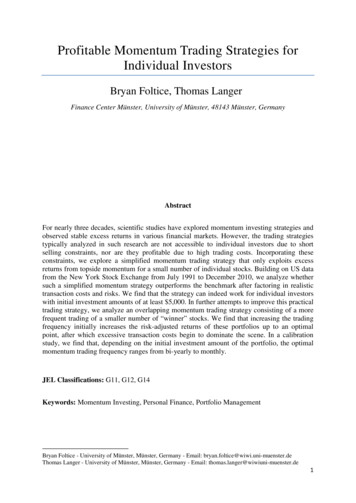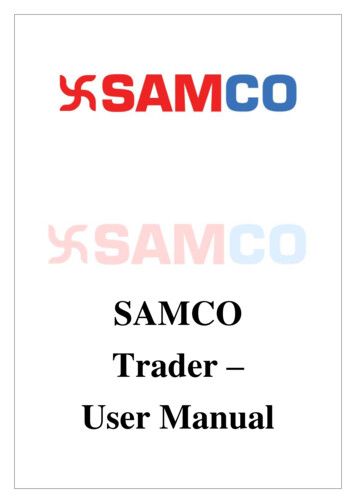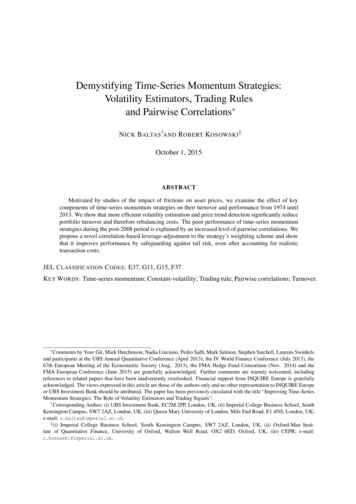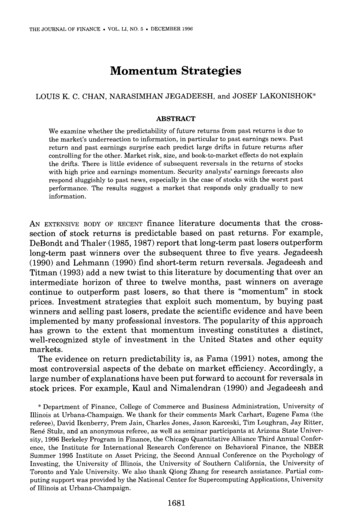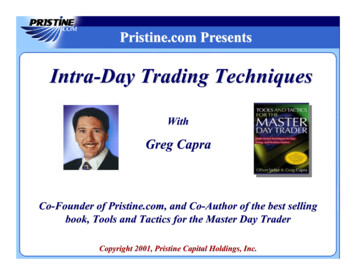
Transcription
MomentumStrategies inIntraday TradingMatthew Creme, Raphael Lenain, Jacob Perricone, IanShaw, Andrew SlottjeMIRAJ AlphaMS&E 448
Origin of momentumstrategies Long-term: Jegadeesh and Titman (1993)o Rank stocks into deciles based on returnso Buy the top decile, sell the bottom decileo Results: Winners with six-month lag generate abnormalreturns for a year (and thereafter lose this return)
Context: Return timelineCloset-1OpentClosetOvernight returnIntraday returnFirst thirty minutesClose-to-close returnLast thirty minutes
Context: Bid-ask bounce Potential explanation for the negative correlation on overnight andintraday returns Consider a stock that closes at the bid and opens at the askSource: PortfolioEffect.com blog
Intraday effects Intraday studies in the 1980s:Wood et al. (1985); Smirlock(1985)o Harris (1986): predictablepatterns in returns throughthe day. Prices rise on allmornings but Mondayo Potentially due to marketmaker inventory controlo Persistent despiteexpansive literature
Starting point:Results from the literatureSimilar experiments: Gao et al. (2014) prove statistical correlation in first thirty/last thirtyreturns on the SPY Branch and Ma (2012) prove overnight/intraday correlation withinequities returns and with SPYAdditional findings: High volatility correlates with strong momentum effects: Zhang (2006)and Gao et al. Half-hour returns predict later performance in those intervals: Hestonet al. (2010) Correlations with size and institutional ownership: Israel andMoskowitz (2013), Hong et al. (2000), Branch and Ma
Objective Develop an intraday momentum strategy that withstandstransaction costs
Challenges Empirical challenges Statistical predictability does not imply profitability - Komarov(2017) Ongoing debate about whether transaction costs will preventprofitso Double bind: if they don’t, the excess returns should getarbitraged away
Preliminary exploration:Google Finance Investigation of sector-specific ETF dynamics called for in theMS&E 448 final paper of Chiquone et al. (2015) Used intraday data publicly available on Google Finance Downloaded all available intraday historical prices for SPDRexchange funds and ran analytics in Python 14 days, 10 ETFs (XTL intraday data was sparse)
Google Finance results
Google Finance results
Google Finance analysisAnalysis: Low R2 and correlation coefficients Suggests arbitrageurs may have disappeared this effect from themarkets But dataset is very limited Effect may also be attenuated in ETF prices from use of futuresin SPDR pricing (Branch and Ma) Working on getting more intraday hard data from onlineproviders to confirm these effects
Onto Quantopian:Preliminary analysis Pulled SPY data in Quantopian over 2002 – 2014 Looked at intraday correlations over half-hour intervals
Success rate
Comparison with middaywindow
Midday window success rate Substantially lower success rate
Results with higher epsilon!
Results with higher epsilon
Correlation chart
Preliminary analysis:Findings This signal does not appear to be very strongo Correlations are lowo P-values are high Inconsistencies comparing first 30/last 30 with midday windows We will need richer data in order to harness this trend to makeprofitable trades
Quantopian backtesting Looked in the timeframe 2010-2013 Universe of stocks: U.S. market top 100 by volume Strategy: if first 30 and penultimate 30 minutes are positive, golong; short if both negative. Close positions each day Initial results:
Backtest results Our first try at a Quantopian strategy had consistent annuallosses Attributable to trading restrictions on the portfolio that didn’t letus buy and sell at the times we wanted. Hard to take advantage ofliquidity effects when we had to sell off at the end of each day. We finessed it a bit and backtested on the S&P from 2010-2013.This gave:
Intraday and the VIX We know that intraday momentum effects are strongest in highvolatility regimes So we run our strategy only when the VIX is over 20, and look at2007 through 2013 This strategy allows us to make money when the market crashesin 2008
Signal boosting with Inferess Can also boost signal by controlling for investor sentiment We were able to obtain no longer publically available data fromInferess Cleaned and organized it Uploaded to Quantopian to find matching stock prices Difficulty: 6 million stock price lookups takes a long time ontheir platform Plan to run machine learning classification on the stocks’movement over various time periods following the time of thesesignals (article publication time)
Signal boosting with Inferess
Backtest results Intraday momentum trading does not appear to be profitable,especially once we account for transaction costs We had limited success constraining these trades to highvolatility regimes We saw success in times when we knew the market would bevolatile, but the same strategy did not produce profits in times ofmarket stability. We would need an additional strategy to runwhen the market is more stable (most of the time)Source:St. Louis Fed
Challenges Difficult to take advantage of foreknowledge of end-of-dayeffects due to limited liquidity Quantopian limits the ability to import large outside datasets:makes it difficult to develop intuition or check precision VIX reflects investors’ anticipated volatility, not recent volatility Data selection issues:o Top 100 stocks induce obvious biaseso Q1500 (Quantopian liquid data) suffer survivorship bias
Next steps:Tactical Get more datao More historical pricing: Bloomberg, Barcharto Investigate extant analysis to optimize next moves strategically Expand analytical breadtho Deploy Inferess data to boost signalso Can perform overnight analysis with daily datao Consider and compare more timeframes, trade frequencieso Expand dataset analysis and visualization beyond ETFs: haven’texamined cross-correlation in stocks (called for in Gao et al.) Continue working on familiarity with the Quantopian platform to dealwith logistical issues
Has intraday momentumgone? It’s happened before:Source: S&P Dow Jones Indices October 2015 paper
A “disappearing anomaly”
Next steps:Strategic“Knowledge of the fact differs from knowledge of the reason for the fact” –Aristotle Ways to build in resilience to transaction costs and liquiditychallenges:o 1) Integration into other strategies There are many known “anomalies” like the first 30/last30 effect; we can look at combining other such anomaliesand incorporating them into strategies Risk of data mining is real: momentum strategies don’twork in Japan (Fama, 2015)
Next steps:Strategic Ways to build in resilience to transaction costs and liquiditychallenges:o 2) Constrain to profitable regimes Like our VIX strategy Risk of insufficient profitability Combine with (1):o Trade first 30/last 30 when volatility is high, and run astat arb strategy when the market is more stableo Trade a long-term momentum strategy and use first30/last 30 price movements to determine trade timeso 3) Outsource to scikit-learn
Intraday momentum trading does not appear to be profitable, especially once we account for transaction costs We had limited success constraining these trades to high-volatility regimes We saw success in times when we knew the market would be volatile, but the same strategy
